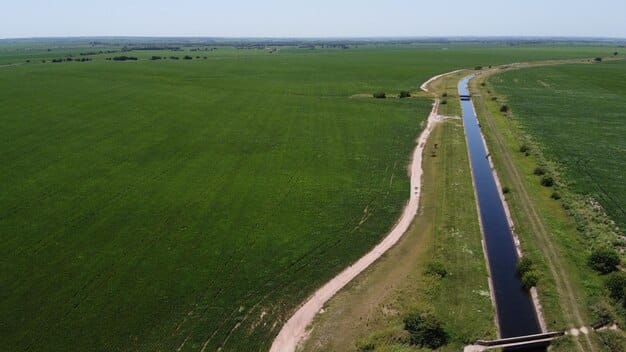US Water Rights Market: Regulatory Changes & Implications

The US water rights market is undergoing significant shifts due to recent regulatory changes, impacting water availability, pricing, and investment strategies across various sectors.
The **US water rights market: Understanding the implications of recent regulatory changes** is becoming increasingly complex. These changes are reshaping how water is allocated, traded, and managed across the country.
Understanding the Us Water Rights Market
The U.S. water rights market is a complex system where different entities—individuals, agricultural businesses, municipalities, and industrial users—hold legal rights to use water from specific sources. These rights are typically governed by state laws, which vary significantly across the country, influencing how water is allocated, managed, and transferred. Understanding the intricacies of this market is crucial for anticipating and adapting to evolving conditions.
Defining Water Rights
Water rights grant permission to use water resources, typically from surface water sources like rivers and lakes, or groundwater aquifers. These rights are often tied to specific properties or uses and can be subject to various conditions and limitations. The precise nature and extent of these rights are defined by state laws, which can differ widely from one jurisdiction to another.
Types of Water Rights
- Riparian Rights: Common in the eastern U.S., riparian rights are associated with land that borders a water source. These rights allow landowners to use water as long as their use is reasonable and does not harm other riparian owners.
- Prior Appropriation: Predominantly used in the western U.S., prior appropriation follows the “first in time, first in right” principle. Senior water rights holders have priority over junior rights holders during times of water scarcity.
- Permitted Rights: Many states require permits for water use, especially for large-scale diversions or withdrawals. These permits specify the amount of water that can be used, the purpose of the use, and any conditions or restrictions that apply.
The U.S. water rights market is a dynamic landscape, shaped by a multitude of factors, including legal frameworks, environmental concerns, and economic drivers. A deep understanding of these market fundamentals is essential for navigating the complexities and capitalizing on opportunities within this vital sector.

Recent Regulatory Changes Impacting Water Rights
Several recent regulatory changes at both the federal and state levels are significantly impacting the US water rights market. These changes reflect growing concerns about water scarcity, environmental sustainability, and the need for more efficient water management practices.
Federal Regulations
At the federal level, regulatory changes often involve environmental protection laws, such as the Clean Water Act (CWA) and the Endangered Species Act (ESA). These laws can impose restrictions on water use to protect water quality and aquatic ecosystems. For example, the CWA regulates discharges of pollutants into waterways, which can indirectly affect water availability for certain uses.
State Regulations
- Water Use Reporting Requirements: Many states are strengthening their water use reporting requirements to improve data collection and monitoring. This allows for better understanding of water use patterns and more informed decision-making.
- Restrictions on Groundwater Pumping: In areas facing groundwater depletion, states are implementing stricter regulations on groundwater pumping to prevent overdraft and protect aquifer levels.
- Water Conservation Incentives: Some states are offering financial incentives for water conservation measures, such as rebates for efficient irrigation equipment or tax credits for water-saving technologies.
Regulatory changes in the U.S. water rights market are driven by various factors, including population growth, climate change, and evolving societal values. Understanding these market drivers is critical for anticipating future trends and adapting to the changing regulatory landscape, ensuring long-term sustainability and resilience.
Implications for Agricultural Water Use
Agriculture is the largest consumer of water in the United States, accounting for roughly 80% of the nation’s consumptive water use. As such, regulatory changes in the water rights market have profound implications for agricultural water users.
Increased Water Costs
Stricter regulations and water scarcity are driving up the cost of water for agricultural producers. This can impact profitability, especially for water-intensive crops or in regions with limited water supplies.
Changes in Crop Selection
Some farmers may need to shift to less water-intensive crops or adopt water-efficient irrigation practices to reduce their water footprint and comply with regulations. Crop diversification can enhance the resilience of agricultural operations in the face of water scarcity.

Investment in Efficiency
- Drip Irrigation: Implementing drip irrigation systems can significantly reduce water consumption compared to traditional flood irrigation methods.
- Soil Moisture Monitoring: Using soil moisture sensors to optimize irrigation scheduling can prevent overwatering and improve water use efficiency.
- Water Reuse Systems: Treating and reusing agricultural wastewater for irrigation can reduce reliance on freshwater sources and minimize environmental impacts.
The agricultural sector faces significant challenges and opportunities in navigating the evolving U.S. water rights market. The ability to adapt to regulatory changes is crucial for ensuring the long-term viability and sustainability of agricultural operations in water-scarce regions.
Impact on Municipal and Industrial Users
Municipal and industrial sectors also face considerable challenges and opportunities in accessing and managing water resources. Regulatory changes and increasing water scarcity are driving significant changes in how these sectors approach water management.
Municipal Water Conservation
Municipalities are implementing various water conservation measures to reduce demand and comply with regulations. These can include restrictions on outdoor water use, incentives for water-efficient appliances, and public awareness campaigns.
Industrial Water Efficiency
Industries are adopting water-efficient technologies and processes to reduce their water footprint and comply with environmental regulations. Closed-loop cooling systems, water reuse programs, and process optimization can significantly reduce industrial water consumption.
Water Trading and Transfers
Municipalities and industrial users are increasingly participating in water trading and transfer agreements to secure reliable water supplies. These transactions can involve purchasing water rights from agricultural users or investing in water infrastructure projects.
The implications of regulatory changes on municipal and industrial water users underscore the importance of proactive water management strategies. By adopting water-efficient technologies, participating in water trading, and embracing innovative solutions, these sectors can ensure a secure and sustainable water future.
Investment Opportunities in the Water Rights Market
The evolving landscape of the U.S. water rights market is creating new investment opportunities across various sectors. Investors are recognizing the value of water as a scarce and essential resource.
Water Infrastructure
Investing in water infrastructure projects, such as reservoirs, pipelines, and treatment facilities, can improve water storage, conveyance, and quality. These investments can enhance water security and reliability for communities and industries.
Water Technology
Water technology companies are developing innovative solutions for water treatment, conservation, and management. Investing in these companies can support the development and deployment of technologies that address water scarcity challenges.
Water Funds
Water funds are investment vehicles that support water conservation and restoration projects. These funds can provide financial resources for watershed management, aquifer recharge, and ecosystem restoration.
Navigating these investment opportunities requires a deep understanding of the U.S. water rights market, regulatory frameworks, and project risks. Conducting thorough due diligence is essential for making informed investment decisions and ensuring long-term value creation.
Future Trends in Water Rights Regulation
Several emerging trends are shaping the future of water rights regulation in the United States. These trends reflect growing concerns about climate change, environmental sustainability, and the need for more equitable water allocation.
Climate Change Adaptation
Water rights regulations are increasingly incorporating climate change considerations, accounting for potential impacts on water availability and demand. This can include adaptive management strategies, drought contingency plans, and restrictions on water use during times of scarcity.
Integrated Water Management
Integrated water management approaches are gaining traction, emphasizing the need to manage water resources holistically across different sectors and scales. This can involve coordinating water management efforts between state and federal agencies, engaging stakeholders in decision-making processes, and promoting collaborative solutions.
Water Data and Technology
Advances in water data and technology are improving the way water resources are monitored, managed, and allocated. Real-time monitoring systems, remote sensing technologies, and data analytics tools are providing valuable insights into water use patterns and ecosystem health.
The future of water rights regulation will likely involve a combination of adaptation to climate change, integrated management approaches, and technological advancements. By embracing innovation and collaboration, stakeholders can ensure a sustainable and resilient water future for the United States.
| Key Point | Brief Description |
|---|---|
| 🌊 Regulatory Changes | Federal and state regulations are evolving, influencing water use and management practices. |
| 💰 Water Costs | Increasing water scarcity and regulations are driving up water costs for users. |
| 🌱 Agricultural Adaptation | Farmers are adapting with efficient irrigation, crop diversification, and water reuse systems. |
| 💡 Investment Opportunities | Investments in water infrastructure, technology, and funds are emerging in the market. |
Us Water Rights Market: FAQ
▼
Water rights are legal entitlements that grant permission to use water from a specific source, such as a river, lake, or aquifer. These rights are typically governed by state laws.
▼
Regulatory changes can increase water costs, prompt changes in crop selection, and encourage investment in water-efficient technologies for agricultural users.
▼
Municipalities can implement restrictions on outdoor water use, offer incentives for water-efficient appliances, and conduct public awareness campaigns to conserve water.
▼
Investment opportunities include water infrastructure projects, water technology companies, and water funds that support conservation and restoration efforts.
▼
Climate change is prompting water rights regulations to incorporate adaptive management strategies, drought contingency plans, and restrictions on water use during scarcity.
Conclusion
Understanding the dynamics of the **US water rights market: Understanding the implications of recent regulatory changes** is crucial for stakeholders across various sectors. Regulatory changes, driven by water scarcity and environmental concerns, are reshaping water allocation, management, and investment strategies. By adapting to these changes and embracing innovative solutions, stakeholders can ensure a sustainable and resilient water future for the United States.





